

Eustatic and Stratigraphic Cycles
Geologists now view earth history as a matter of evolution in which some changes are unidirectional (at least, in net effect), others are oscillatory or cyclic, and still others are random fluctuations, while the whole is punctuated by smaller or greater catastrophes. Stratigraphy is a typical example of a cyclic geological event. Exxon‘s geologists explained the cyclicity of Stratigraphy as a consequence of eustatic changes. They assumed that:
1) Eustasy was the main parameter controlling the stratigraphy.
2) Each hierarchical eustatic cycle induces a correlative stratigraphic cycle.
However, one must not forget that the time duration of a eustatic cycle is always longer than the sum of sedimentary deposition time. In fact, one of the first things we learn in stratigraphy is, for instance, that the Cretaceous system in rocks is the equivalent of the Cretaceous period in time. But this is almost certainly not true. The completeness of the stratigraphic cycles is always lower than 1. The rock record is so episodic in its accumulation and so incomplete in its preservation that there have almost certainly been worldwide gaps during which no sediments were deposited, or eroded.
Four types of stratigraphic cycles (Plate 295) are usually recognized in association with the different orders of eustatic cycles:
A) Continental encroachment cycles ;
B) Continental encroachment sub-cycles ;
C) Sequence cycles ;
D) Parasequence cycles.
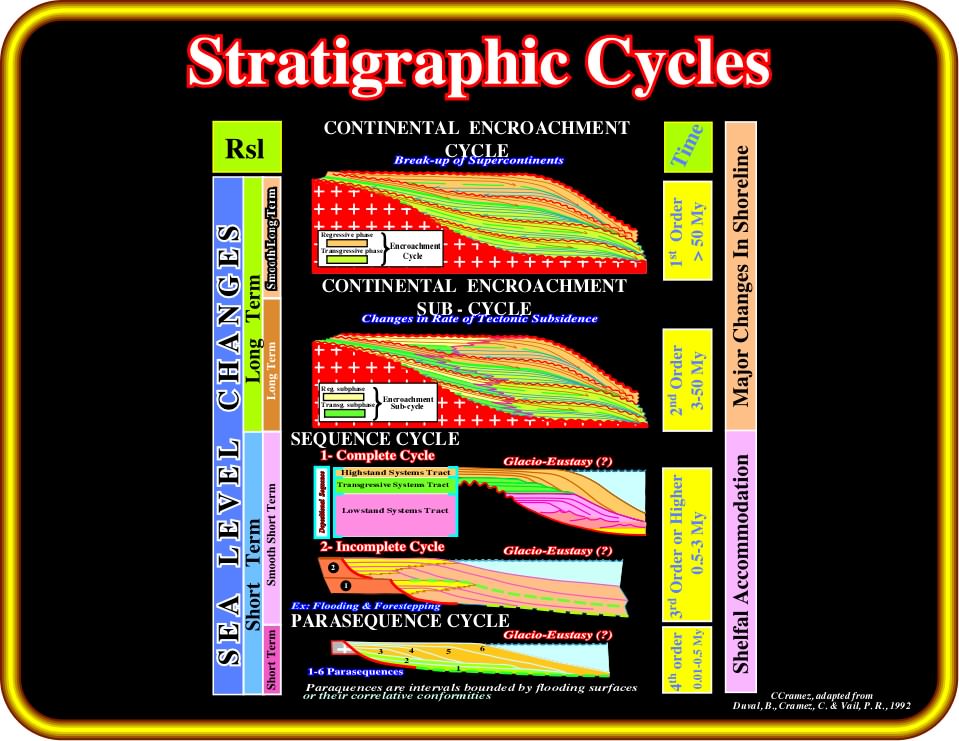
Plate 295 - The hierarchy of stratigraphic cycles proposed by Duval et al. (1993) takes into account four stratigraphic cycles: (i) Continental encroachment cycle ; (ii) Continental encroachment sub-cycle ; (iii) Sequence-cycle and (iv) Parasequence cycle. These stratigraphic cycles are deposited during eustatic cycles of 1st, 2nd, 3rd and 4th orders, that is to say, eustatic cycles with time durations higher than 50 My, between 3-5 and 50 My, between 0.5 and 3-5 Ma and between 0.01 and 0.5 My.
A) Continental Encroachment Cycles
These cycles are associated with 1st order eustatic cycles (Plate 295 & 296). They are characterized by a succession of coastal onlap against the cratons. They fossilize the unconformity created by the aggregation of Supercontinents. Two continental encroachment cycles have been recorded since the beginning the Phanerozoic:
(i) The Paleozoic cycle ;
(ii) The Ceno-Mesozoic cycle.
Both continental encroachment cycles are recognizable in all continents. They are believed to be global. Taking into account that the Latest Proterozoic represents the time of slow encroachment with regression, we can say that:
1) During the Paleozoic cycle:
1.1) Cambrian represents the time of extensive encroachment with transgression ;
1.2) Ordovician represents the eustatic high ;
1.3) Silurian to Permian represents the time of restriction.
2) During the Ceno-Mesozoic cycle:
2.1) Triassic represents a time of gradual encroachment of sediments onto the craton. Greatest thickness of nonmarine sediments was deposited in grabens (rift-type basins) and bordering marine basins. This general pattern is believed to be caused by a slow relative rise of sea level due to slow longterm rise in eustasy. Nonmarine rocks were widespread because sediment supply exceeded the space being created by slow relative rise, resulting in major regression.
2.2) The Jurassic and Lower Cretaceous represent times of extensive encroachment of sediments on to the continental margins. These sediments are predominantly marine. During this time period, average relative sea level rose more rapidly due to an increase in the rate of rise of long-term eustasy. Marine rocks are dominant. Sediment supply did not keep up with the new space being created by more rapid relative rise, resulting in overall transgression.
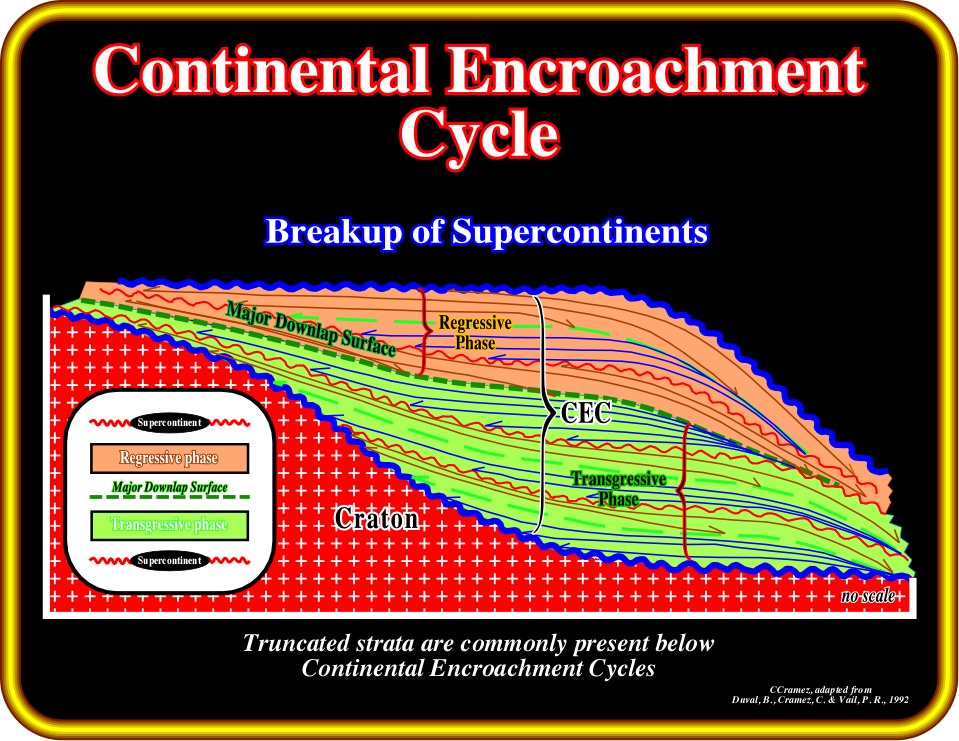
Plate 296 - A continental encroachment cycle (CEC) is developed between the breakup of a supercontinent and the formation of a new one. The transgressive phase, which globally has a backstepping or retrogradational geometry, corresponds to the dispersion of the new continents, while the regressive phase, with a forestepping or progradational geometry, corresponds to the gathering of the continents to form a new supercontinent. The transgressive phase is induced by an eustatic rise and the regressive phase is induced by an eustatic fall. A major downlap surface separates these sedimentary phases. Within each phase, a set of continental encroachment sub-cycles, bounded by unconformities, with transgressive and regressive sub-phases separated by downlap surfaces, is easily recognized.
2.3) The Lower Turonian is believed to have been the time of the maximum eustatic high ;
2.4) The upper Cretaceous and Cenozoic are characterized by an overall gradual restriction of sediments to the continental margins and basinal areas. This pattern is believed to be caused by the slow long-term fall of the eustasy causing a decreasing relative rise and regression or relative fall and exposure.

Plate 297 - This tentative interpretation of a seismic line from Angola offshore illustrates the post-Pangea or Ceno-Mesozoic, continental encroachment cycle continent (CEC), which is generally assumed to start with the breakup of the lithosphere, since the rift-type basins are generally associated with the lengthening of the Pangea. The geometries of both stratigraphic phases are easily recognized, in spite of the salt tectonics in the transgressive phase. The geometry of the transgressive phase is retrogradation al (thickening landward), while the geometry of the regressive phase is progradational (thickening seaward). The major downlap surface (MFS 91.5 Ma), with which potential marine source-rocks are associated, separates the transgressive and regressive phases.
B) Continental Encroachment Sub-Cycles
These cycles (Plates 298 to 300) are associated with 2nd order eustatic cycles:
- Continental encroachment sub-cycles are characterized by unconformities induced by major basinward shifts of coastal onlap ;
- The basinward shifts interrupt the continuity of continental encroachment associated with breakup of Supercontinents.
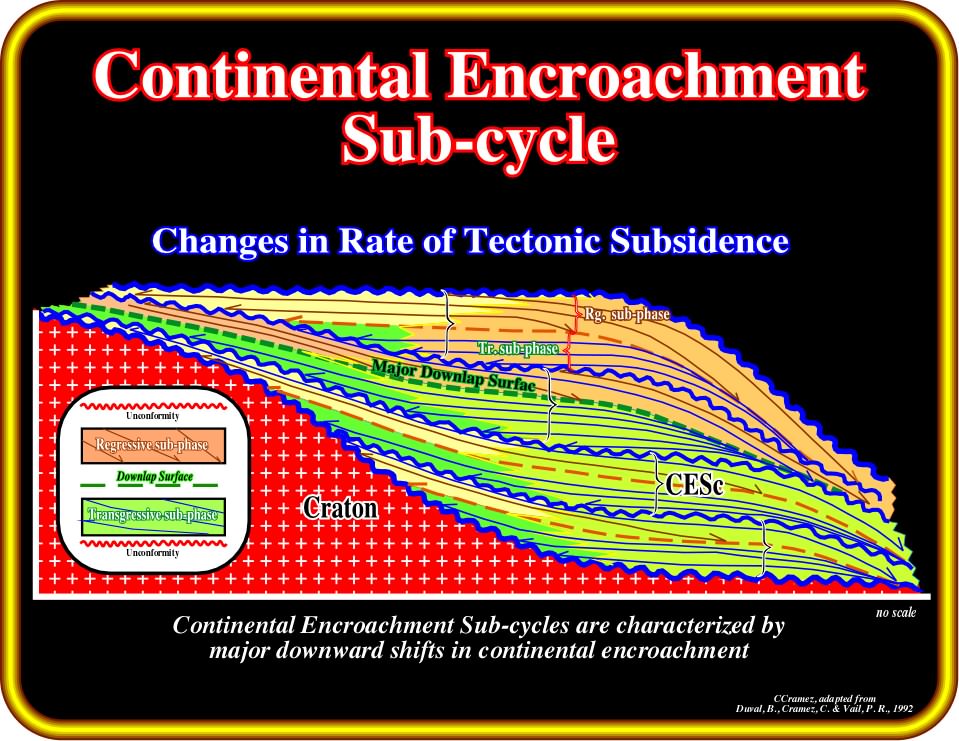
Plate 298- As illustrated, a continental encroachment cycle (CEC) is composed of continental encroachment sub-cycles (CESc), which are bounded by unconformities and composed of transgressive and regressive sub-phase separated by minor downlap surfaces. The transgressive sub-phase has backstepping geometry while the regressive sub-phase has forestepping geometry. As might be expected, continental sub-cycles are induced by changes in the rate of tectonic subsidence which creates major downward and basinward shifts of coastal onlapping. In certain petroleum basins, secondary potential source-rocks are associated with the downlap surfaces of continental encroachment sub-cycles.
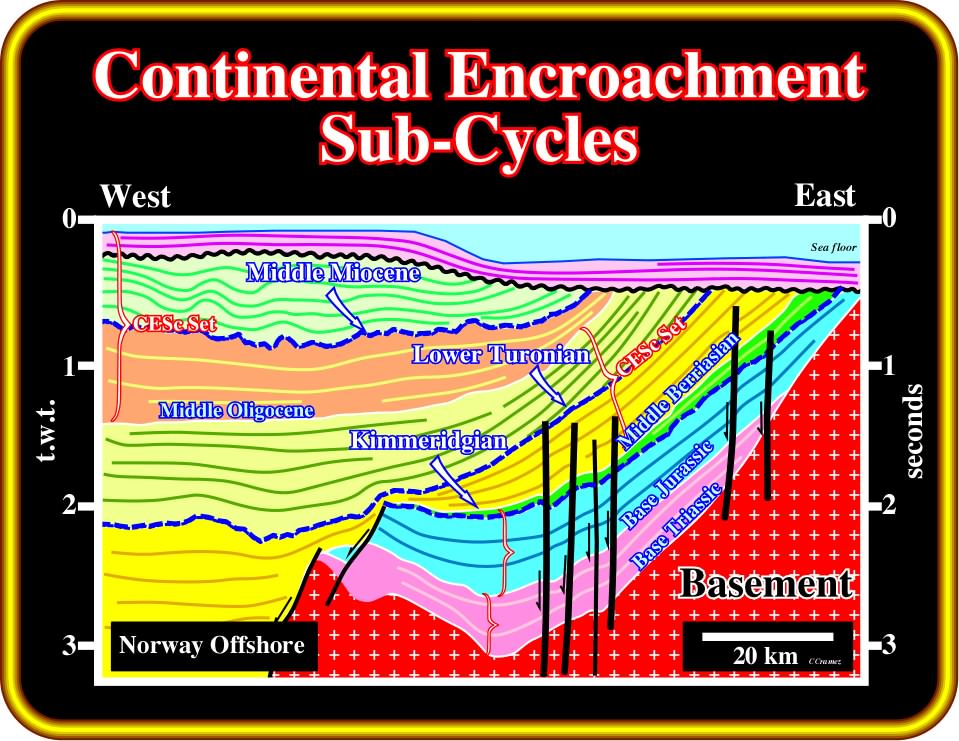
Plate 299 - On this tentative interpretation of a seismic line from offshore Norway, the seismic interpretation was performed in continental encroachment sub-cycles (CESc). However, just the more evident downward shifts of coastal onlap were identified and picked. The interpretation was done in continental sub-cycle sets. Each CESc set is bounded by onlap and truncation surfaces or correlative conformities, that is to say, by unconformities. A significant downlap surface can be recognized in each CESc set. Three downlap surfaces, with organic rich condensed stratigraphic sections, are evident: (i) Middle Miocene, (ii) Lower Turonian and (iii) Kimmeridgian. Taking into account the isostatic rebound, which is obvious in the eastern part of the line, it is not surprised that just the organic matter associated with the Kimmeridgian downlap surface reached maturation.
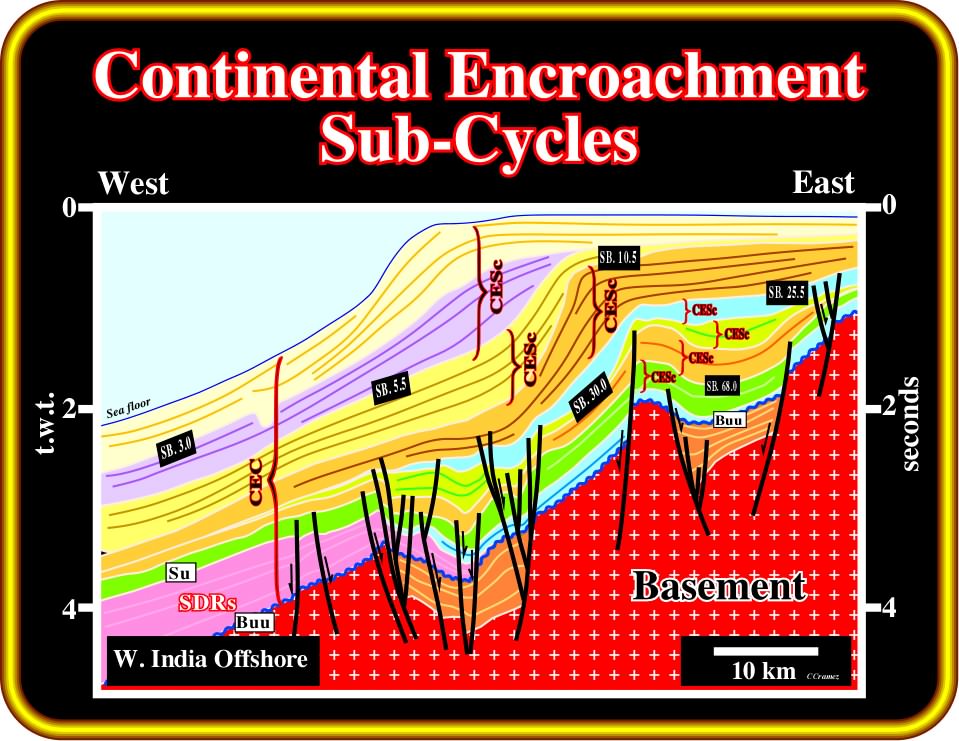
Plate 300- On this tentative interpretation (offshore India), within the post-Pangea continental encroachment cycle (CEC), which is limited by the BUU (breakup unconformity) and the sea floor, several continental encroachment sub-cycle sets can be recognized. The major unconformities bounding the CESc sets correspond to significant basinward and downward shifts of the coastal onlapping. According to the stratigraphic signature proposed by P. Vail and the results of the exploration wells, from top to bottom, the unconformities are: SB. 5.5 Ma, SB. 10.5 Ma, SB. 25.5 Ma, SB. 30 Ma and SB. 68 Ma. Note that SB. 10.5 Ma means that the age of unconformity, which is a sequence boundary (SB), is 10.5 million years ago.
These cycles (Plate 301 to 306) are associated with 3rd order eustatic cycles.
- They are bounded by unconformities induced by changes in water depth, i.e. accommodation in the margins of the basins.
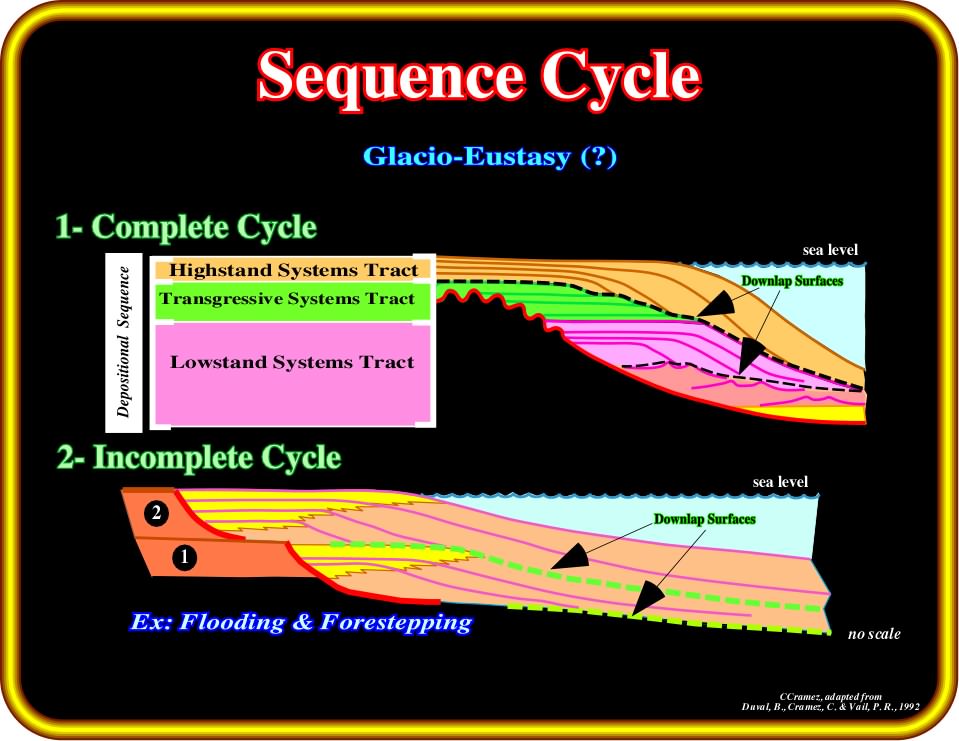
Plate 301 - Sequence-cycles are associated with 3rd order eustatic cycles. They are bounded by unconformities, which are induced by relative sea level falls that either totally or partially expose the shelf. They are defined by regional onlap surfaces. The difference of age between the bounding unconformities ranges between 0.5 Ma and 3-5 Ma. They are formed by a stacking of linked coeval depositional systems (systems tracts) and two downlap surfaces can be recognized. Sequence-cycles, as illustrated above, can be complete (with all systems tracts) or incomplete (one or several systems tracts missing).
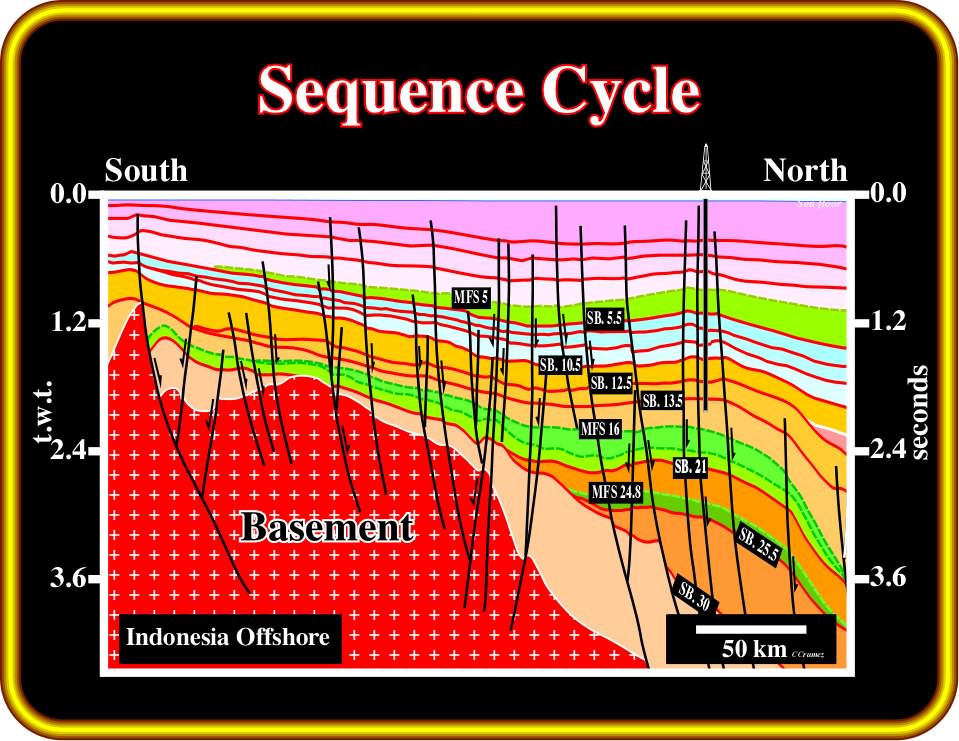
Plate 302 - On this tentative interpretation (offshore East Natuna), the seismic interpretation was performed in sequence-cycles (high hierarchic level of interpretation). However, it is quite difficult, particularly due to the horizontal and vertical scales, to identify the systems tracts composing the different sequence-cycles. Except for few downlap surfaces, such as MFS. 5 Ma, MFS. 16. Ma and MFS. 24.8 Ma, which emphasize the major transgressive events of the Neogene, only the bounding unconformities can be picked. Some of them have been calibrated by the results of the well, while the age of the others is based on the stratigraphic signature of the area. The age difference between consecutive unconformities is not higher than 3-5 My.
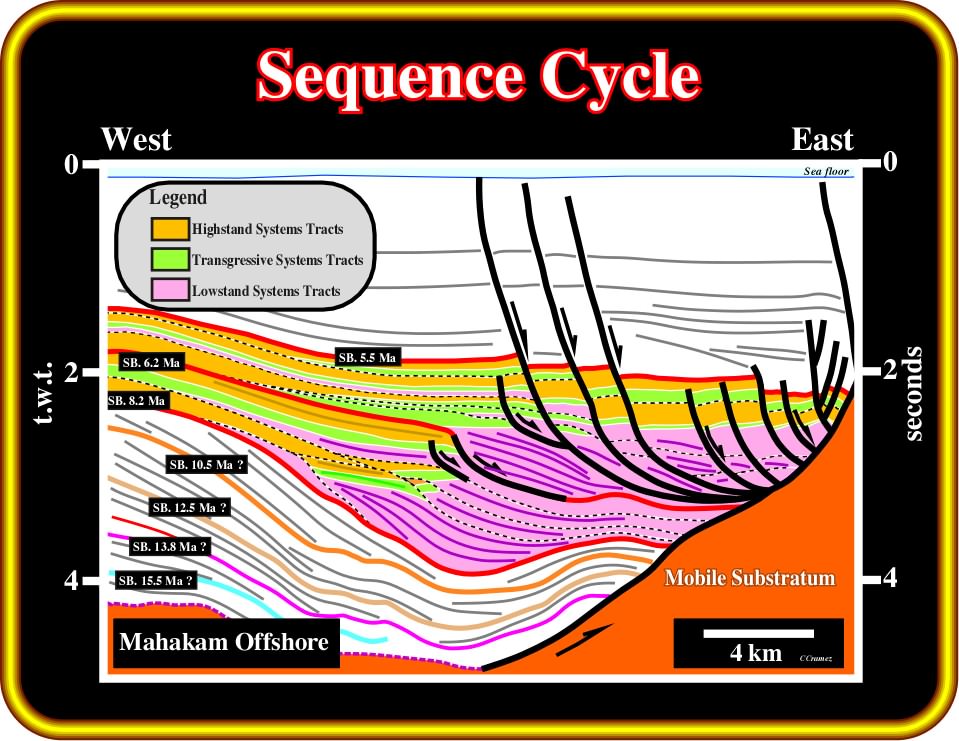
Plate 303 - On this tentative interpretation of a seismic line of offshore Kalimantan, where the rate of sedimentation is quite strong, the picking of the sequence-cycles and systems tracts is quite easy. Taking into account the reflections terminations, between the sequence boundaries 5.5 Ma and 8.2 Ma, it is possible to interpret high frequency sequence cycles. In spite of the fact that so far no basin floor fans have been drilled, the three uppermost unconformities are quite well calibrated and dated. The ages of the lower unconformities are hypothetical and based on the stratigraphic signature of the Neogene recognized in SE Asia.
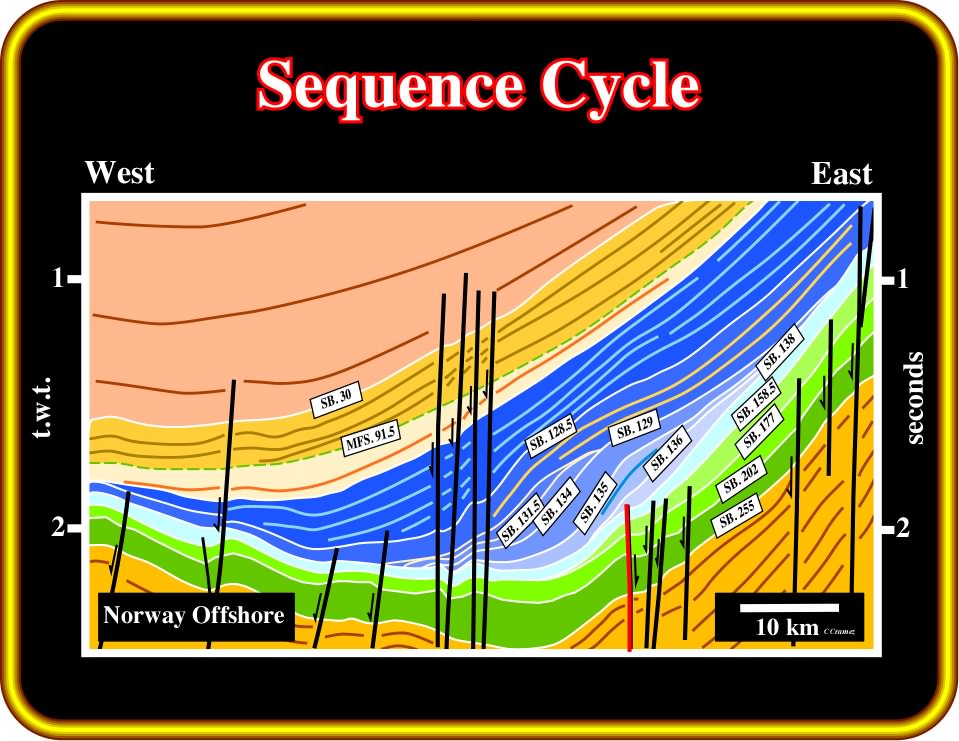
Plate 304 - On this tentative interpretation (offshore Norway), the majority of the sequence cycles associated with the Kimmeridgian downlap surface seem to be incomplete. Between SB. 128.5 and SB. 138, six sequence cycles were recognized by reflections terminations. However, they seem be composed just by forestepping systems tracts, most likely highstand systems tracts. In the North Sea and offshore Norway, the source rocks are associated with the downlap surface along which all these Upper Jurassic sequence cycles seem to condensate or terminate.
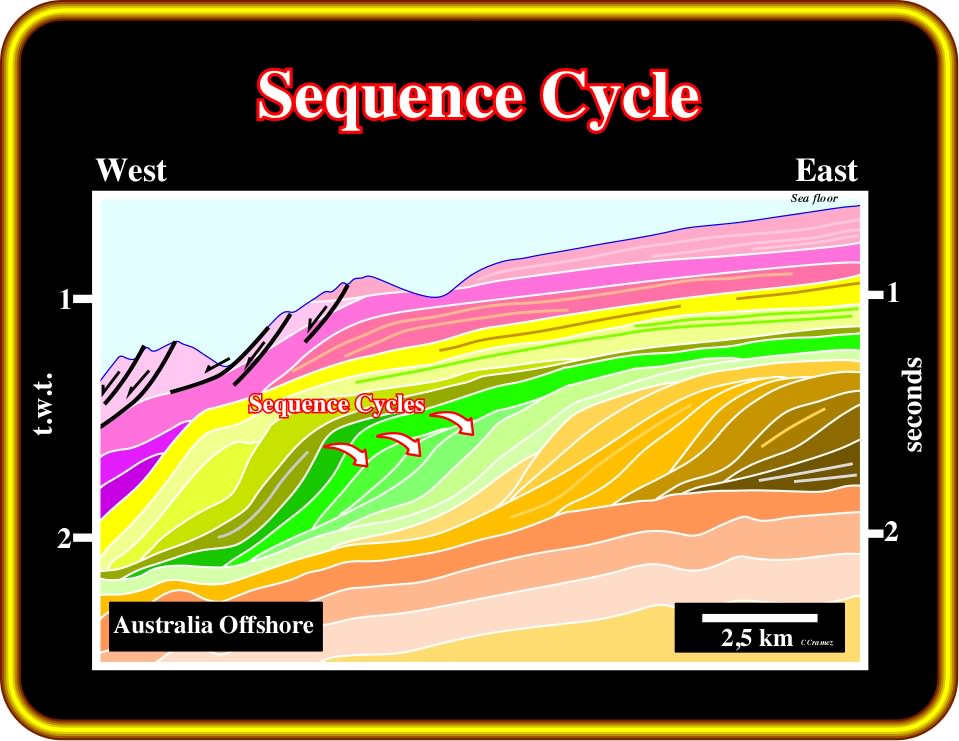
Plate 305 - When progradation is predominant, that is to say, when upbuilding (vertical deposition) is small in relation to outbuilding Lateral deposition), very often, some of the sequence cycles are incomplete (one or several of the systems tracts are missing). On this tentative interpretation of a seismic line from Australia offshore associated with the breakup of the Pangea, it is evident that some sequences are incomplete. Transgressive and highstand systems tracts are often missing.
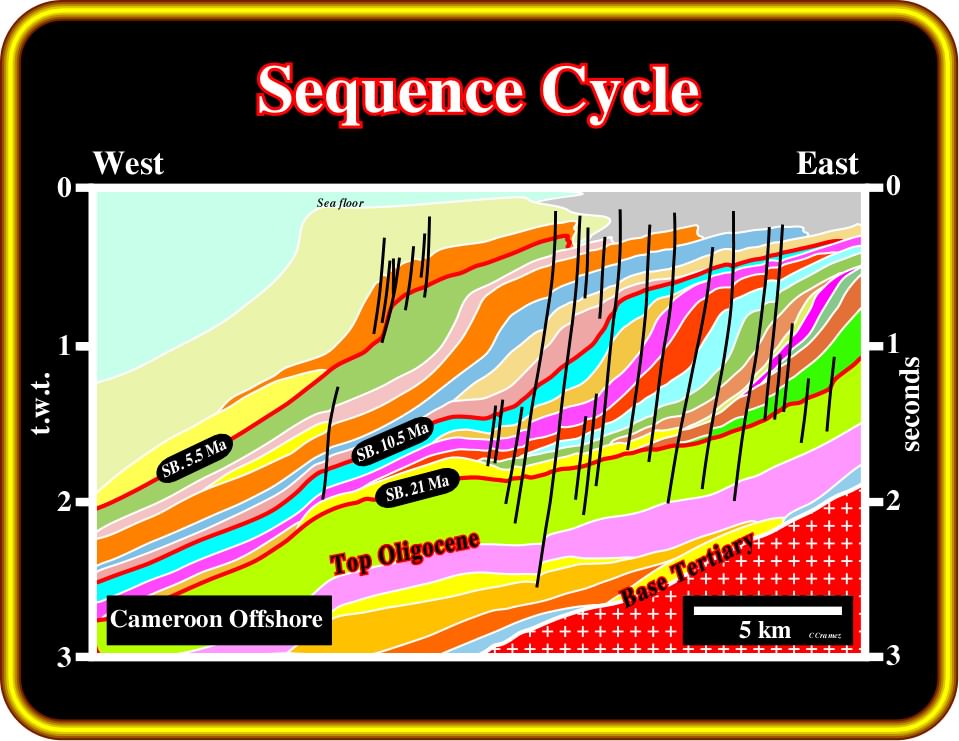
Plate 306 - On this tentative interpretation Cameroon offshore), three principal sequence cycles sets are considered. They are bounded by the unconformities SB. 5.5 Ma, SB. 10.5 Ma and SB. 21 Ma. The majority of the distal sequence cycles seem complete. They seem to be composed by all systems tracts. Taking into account the vertical scale, the individualization and picking of the systems tracts is rather impossible. When upbuilding (vertical deposition) is significant, we guess that a sequence cycle (lateral deposition) is complete. Contrariwise, when upbuilding is small or no existent, the more likely is that the sequence cycle are incomplete.
These cycles are associated with 4th order eustatic cycle or higher.
- They are bounded by two consecutive flooding surfaces (Plate 307).
Take note that:
(i) In deep water environments, with exception of parasequence cycles, all stratigraphic cycles are characterized by the onlap of turbidites and debris flows ;
(ii) In shallower water settings, stratigraphic cycles are characterized by onlap of strata deposited in deltaic, coastal or fluvial environments ;
(iii) Subaerial and submarine erosional truncations are commonly present below the boundaries of the cycles ;
(iv) Toplap geometrical relationships, indicating sediment bypassing, are common under the boundaries of all stratigraphic cycles, particularly in areas of rapid progradation ;
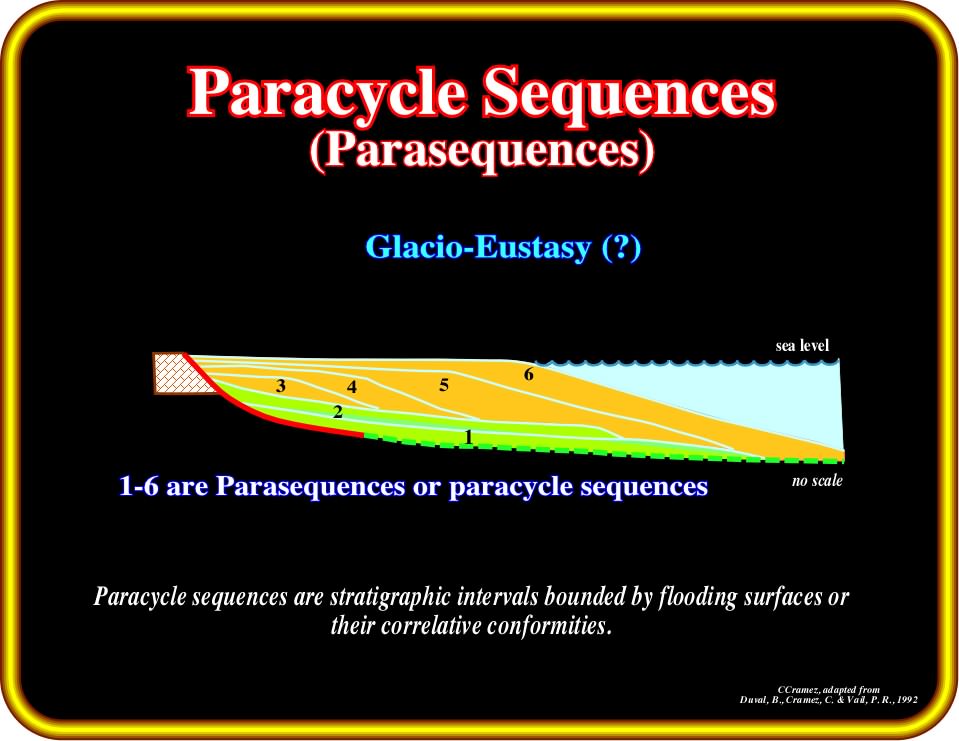
Plate 307 - As illustrated on this sketch, paracycle sequences or parasequences are stratigraphic intervals, bounded by flooding surfaces or their correlative conformities, which stack to form systems tracts. There is not relative sea level fall between each paracycle sequence, that is to say, they are not associated with eustatic cycles but with eustatic paracycles. The recognition of paracycle sequences is quite easy on the ground, but on seismic lines it is relatively difficult since, quite often, the paracycle sequences are under the seismic resolution.
In spite of the scale problem, discussed next, and resolution of seismic data, we believe that in sequential stratigraphy, particularly when performed on seismic data, a hypothetico-deductive procedure (as proposed by K. Popper, 1934) is more appropriate than inductive procedures.
In these notes, as you have probably already noticed, a discursive approach has been adopted. So, the different stratigraphic cycles must be studied in a decreasing hierarchical succession, i.e. from the cycles deposited during 1st order (low hierarchy) eustatic cycle downward to 3rd or 4th order (high hierarchy).
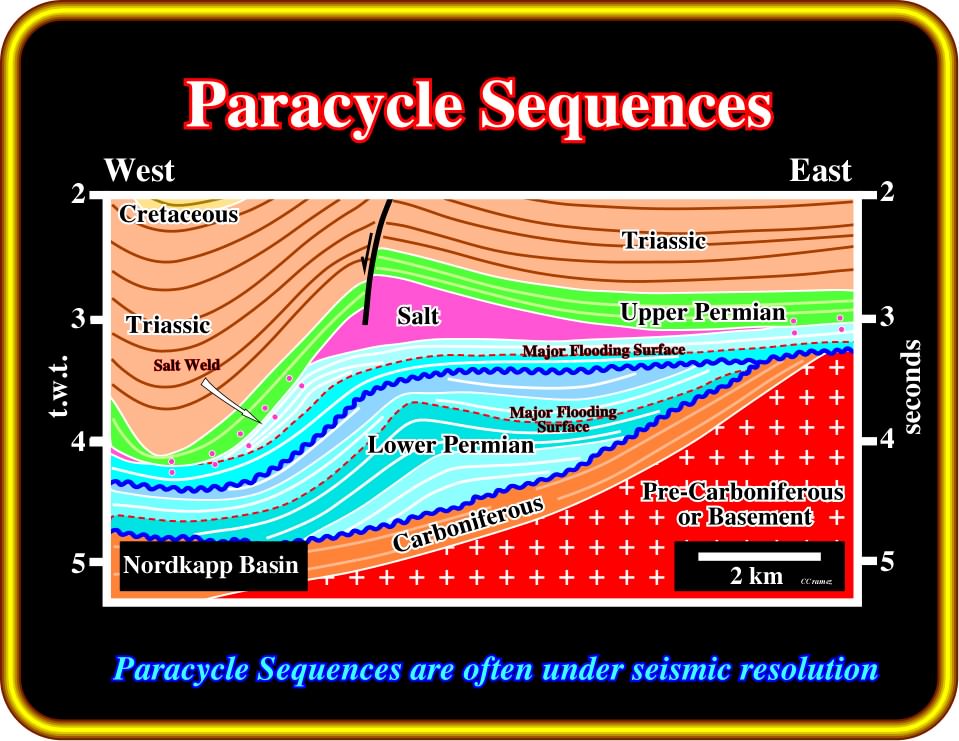
Plate 308 - As said previously, parasequences, which are limited between consecutive flooding surfaces, are easily to recognize on the ground and on electrical logs. Taking into account the scale of the seismic lines and particularly the vertical time scale, only the major flooding surfaces can be recognized as illustrated on this tentative interpretation of a seismic line of Norkapp basin (Offshore Norway) by the Lower and Middle Permian flooding surfaces. Obviously, the seismic interval between them does not correspond to a parasequence cycle. Do not forget that paracycle sequences are deposited during eustatic paracycles which form 4th order eustatic cycles, with time duration ranges between, 0.01 and 0.5 My. So, even in areas with normal sedimentation rates, their average thickness is metric, i.e., under seismic resolution.